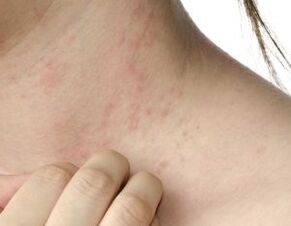
Timely detection of the disease is the key to successful treatment. This rule is especially true for diseases that are very difficult to treat. These include lichen scales, more commonly known as psoriasis. In recent decades, the disease has spread to more and more areas, affecting infants and retirees, and turning statistics in a sad direction.
It's not for nothing that paid lichens are attracting so much interest. Today, psoriasis has shifted from the classification of common skin diseases to systemic pathologies. Patients with this disease have been found to be more susceptible to infections, heart disease, depression and diabetes. Given the lack of a unified treatment system, it is very important to identify psoriasis in the early stages.
The first signs of psoriasis
The symptoms of this dermatosis are also known to those who do not have a similar problem. A common symptom of lichen scales is a colored skin rash.
This rash appears in inflamed areas of the epidermis, can be large or intermittent, with scaling and sometimes purulent filling. Each individual element of such a rash is called a papule. Observations of patients with psoriasis have shown that the first symptoms of this disease can appear even before the appearance of papules on the body.
In most cases, there is a change in mood, loss of appetite and indigestion before the appearance of a rash. It has often been reported that depression for no apparent reason appears too often a few days before the first papules appear. The problem is that patients with similar symptoms do not see a reason to go to the doctor. However, even if you consult a doctor in a timely manner, a specialist is always far from determining the true cause of such a situation and making a correct diagnosis.
A rash on the body is the main symptom of psoriasis. Depending on the type of lichen (and there are dozens), the area of the lesion, and the age of the patient, the disease can manifest itself in different ways.
Manifestations in children
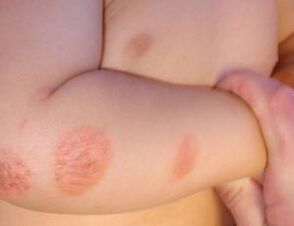
Paid lichen can occur in infants. This is very rare, but is often exacerbated by the parents themselves. The first signs of the disease may resemble prickly heat or allergies, so adults rely on their knowledge and treat the child alone. In most cases, babies with psoriasis consult a doctor when the disease develops.
In infants, scaly lichen is most often seen in wrinkles: in the inner thighs, under the armpits, between the toes and hands, in the skin wrinkles on the neck. The appearance of papules is often accompanied by itching, so the baby may be very anxious, do not sleep at night and refuse to eat.
Damage is similar to diarrhea, diaper rash or eczema. Inflamed skin becomes red or pink and becomes hot to the touch. Pustules can be clearly visible or can form all the spots - plaques. As a rule, such spots rise above healthy skin. A distinctive feature of psoriatic plaques is the presence of dry crusts and scales on the rash, but in a baby, papules and plaques often occur in areas of sweating, which moisturizes the surface of the inflammation.
When these symptoms occur, it is important not to waste time on folk remedies and advice of the older generation. If there is evidence in the newborn (of any nature), it should be seen immediately by a pediatrician and dermatologist. Treatment of psoriasis in infants is not much different from adult therapy, the baby is given therapeutic non-hormonal ointments, in severe cases, pills and injections.
The initial symptoms of lichen scales in older children do not differ from adults. However, children can suffer from all kinds of psoriasis:
- Plate- the most common. The signs are dry, red, hot spots. The papules are covered with a hard crust with pale scales on the surface. It can be seen anywhere, can be attached to guides or boards. Most itch, but not necessarily.
- Pustules- characterized by the presence of fluid or pus inside the papules. The initial stage is the same as with plaque: papules with open edges rise to the surface of the epidermis, but are filled with fluid.
- The hairy part of the head- may look like dandruff, but over time it forms a very crusty crust on the entire surface of the head or part of it. The hair in the affected area becomes thinner and thinner. This type of psoriasis often appears in the wrinkles behind the ears.
- Palmar-plantar- almost absent in children. It differs in localization in the palms and soles, there are "lakes" with rough skin and scales.
- Flexion surfaces- most often occur on the elbows, knees, genitals. It differs from other types of psoriasis by the lack of scales. The affected skin is covered with a smooth and firm crust, resembling a single point raised above the surface of a healthy epidermis. Color - pale pink, gray-white, pink.
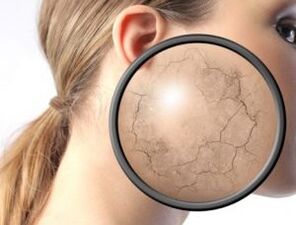
You should consult a dermatologist for local peeling and inflammation of the skin. In children, psoriasis progresses very quickly, especially if accompanied by itching.
Damaged papules are easily infected, grow, and cover an increasingly large area. It is important to constantly monitor the child after the prescribed treatment regimen, to prevent scratching and new injuries on the body, and to follow a diet.
Manifestations in women
The first stage of psoriasis can manifest itself at any age, but most of the first diseases occur before the age of 20, although the disease can "sleep" for up to 50 years. Adult men and women experience the same symptoms as adolescents. At a later age, the risk of developing psoriasis on the heels, nails and joints increases.
World disease statistics show that women suffer almost a corner more than paid lichen, and the main proportion of this is the fight against plaque psoriasis. It is not known exactly what causes this selectivity, but scientists suggest that a hormonal factor is among the causes of psoriasis.
According to the same hormones, the symptoms of scaly lichen in girls most often manifest themselves during PMS when the hormonal background changes. In addition, a woman's natural sensitivity makes her more sensitive to stress, depression, neurosis. For a person prone to psoriasis, any psychological instability can lead to the disease.
Other causes of disease exacerbation:
- skin damage (burns, cuts, open wounds);
- allergic reactions;
- infectious diseases;
- metabolic disease;
- bad habits and harmful diet.
In fact, if a woman has a genetic predisposition to psoriasis, one of the irritants will sooner or later cause the disease. To prevent such exacerbations in the future, the patient should carefully monitor their lifestyle.
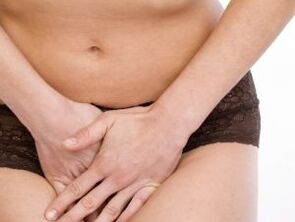
The symptoms of psoriasis in women are the same as in men, except that the sex difference affects the external genitalia. In the genitals, girls experience plaque-like and inverted appearances, sometimes pustules. The first symptoms are inflammation of the skin on the labia or pubis, rarely affecting the mucous membranes.
Small pinhead papules may appear as numerous or as a single patch. Genital psoriasis scales are rarely seen because the location does not allow air to enter. A distinctive feature of psoriatic rash is that the papules and plaques rise slightly above the surface and become hot. With such symptoms, you should immediately consult a dermatologist and gynecologist.
Manifestations in men
As mentioned earlier, half of men suffer from lichen, which pays slightly less than women. However, the course and symptoms of the disease remain the same for both halves. A study and analysis of patients revealed that the first symptoms appear in men at the age of 22-25 years, and in women from the age of 15 years. Such "delayed" symptoms are associated with the subsequent arrival of a hormonal imbalance in the strong half.
Psoriasis starts in the same way in men. In most cases, small papules with silver scales appear first, and then merge into large spots - plaques and "paraffin lakes".
Guttate psoriasis affects large areas of the body at once, but with separate small joints.
If you examine the inflammatory elements carefully, you can distinguish psoriasis from other skin diseases at home:
- On the surface of papules and plaques, a dense, rough crust forms. The white scales on the surface look like sawdust when shaved.
- If you completely remove the scales from the papule, a thin transparent film remains on it.
- When removing the film from the psoriasis element, large drops of blood appear here because of the large number of capillaries in the papules.
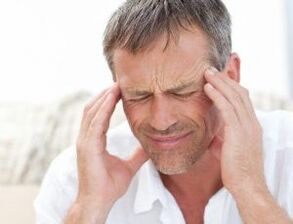
In addition to the obvious symptoms, scaly lichen is sometimes accompanied by general weakness, depression and fever. Psoriatic elements may vary in shape, for example, a small number of small individual papules appear with a single lesion. Infection of a large part of the body (all the back, sides, abdomen, legs) occurs with psoriasis with tears, and papules are in the form of drops. Large, localized patches are a sign of coin psoriasis.
Based on observations of patients of both sexes, scientists have concluded that squamous lichen is more severe in men and has a higher incidence than women. Experts say this is due to the fact that they do not want to be treated simply. However, the weaker half are more attentive to their health and prophylactically seek medical attention more often than the stronger sex. The only type of psoriasis that men do not hesitate to treat is the genitals. A plaque-like, inverted, or pustular appearance may appear on the glans penis, scrotum, or pubis.
Given the sensitivity of the skin in these areas, inflammation progresses very quickly and requires immediate treatment. When any rash is found on the genitals, it is not worth spending time on "self-examination" and self-medication. Excessive peeling of the skin without red inflammation and itching is considered a reason to go to the doctor.
Psoriasis of the nails (scalp) and scalp is also common in men. According to dermatologists, these two types are most often started by men. Although there are many photos of the disease with symptoms on the Internet, the symptoms of paid lichen are perceived as fungal or dandruff, and the doctor is already in a progressive form.
In case of damage to the scalp, severe crumbs, sometimes itching, rough crusts appear in places or on the entire surface of the scalp. Psoriasis of the nails manifests itself with discoloration of the nail, the appearance of depressions and deposits, nail plate and compression of the surrounding skin. The classification of symptoms will be discussed in more detail below.
Thus, the symptoms of psoriasis do not differ in children, women and men. Any inflammation on the skin of the body, head or nails is a reason to seek medical attention. If the affected areas do not itch or break, this does not mean that the skin is not affected by psoriasis.
Psoriasis Symptoms
The first symptoms of the disease usually last for a few days, after which they begin to progress rapidly. Sometimes the disease can develop very slowly, and the initial symptoms are "delayed" for a week or more. In any case, the disease will sooner or later enter a full-fledged stage. The localization of psoriasis often misleads both patients and professionals themselves. In the first manifestations, it is very difficult to distinguish the same psoriasis of the nails from a common fungal infection.
Manifestations on the scalp
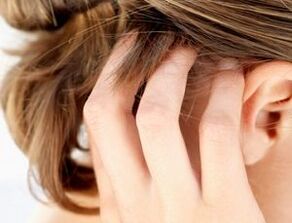
In the early stages of development, psoriasis on the scalp looks like a small skin. Gradually the affected areas turn red, can hurt and itch, sometimes extending beyond the hairline: behind the head, behind the ears, on the forehead. In inflamed areas, the epidermis becomes denser, and the dense structure of the psoriasis is one of the distinguishing features.
This is often confused with seborrhea, in which the scalp is also severely peeled. However, unlike seborrhea, psoriasis elements bleed if the upper scaly layer is removed from them. In addition, psoriasis is characterized by roughness of the affected skin. If this rash is accompanied by severe itching, patients often aggravate the condition by traumatizing plaques and papules. Open wounds become infected quickly and the disease progresses.
This type of paid lichen is seen in children and adults. Attempts at self-medication often worsen the picture of the disease, so it is better to consult a specialist at the first suspicion of psoriasis. A trichologist and a dermatologist can accurately understand the nature of the inflammation, it is better to show the child to the leading therapist first.
Manifestations on the skin of the body
In the body, the first papules appear primarily in wrinkles and friction areas: knees, armpits, elbows, neck. Manifestations may vary depending on the type of psoriasis. As with children, adults can experience many types of the disease, but a few more points are added to the list above.
In addition to the most common paid lichen species, people over the age of 18 may encounter:
- Pustules,, do not differ in symptoms in adults and children. It affects any part of the body and is characterized by a heavy gait. Often accompanied by fever and general weakness. Papules are initially filled with a clear fluid that differentiates this type of disease from others. If they are damaged and re-infected, they will appear pus.
- Erythrodermic psoriasis. It is a very complex form of the disease, often not immediately apparent, but progressing from plaque or pustules. But an independent course is also possible. Unlike normal psoriasis, it affects large areas of the body and develops very quickly. Papules may be "empty" or filled with pus. If psoriatic elements affect large areas of the body, causing pain and growth at a high rate, it is most likely erythroderma.
- In the form of tears,, as we already know, is characterized by clear and frequent skin lesions. At the beginning of the disease, the papules are very small, the edges are well defined and in the form of bulging tears. At the first sign, it affects small areas of the body, but gradually grows. It can be seen on the arms, legs, abdomen, back, neck.
- Artificial psoriasis.The worst thing that can happen with this disease is damage to the joints. This often happens in people who already have one type of psoriasis, but which may seem like an independent disease. Initially, it affects the small joints: the phalanges of the fingers and hands, often moving to more important places. The first symptoms for him are pain and soreness in the joints, fever, swelling of the phalanges of the fingers.
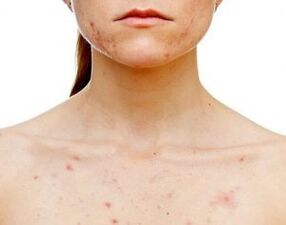
Arthritis and erythrodermic psoriasis are especially dangerous because they cause more serious complications. In the case of joint damage, the disease poses a real risk of disability. However, the most severe forms of the disease are most often seen in patients with psoriasis.
Manifestations in the legs
The feet are most affected by the knee area, which can be inverted or plaque psoriasis. In this case, the knee is completely or partially covered with a dense crust with a rough white surface. Often, the same thing happens with the defeat of the knees at the elbows, but not necessarily. We have already learned how to identify psoriasis with papules.
In addition, the feet are a lesion area that spreads like teardrops. In this condition, most of the leg is also covered with small papules that cover the area from the lower leg to the thigh. The elements become inflamed, hot, sometimes itchy and bruised.
Roughness of the skin, painful itchy calluses on the feet indicate plantar psoriasis, and can also "touch" the palms. This is a very common form of the disease because the feet are most susceptible to mechanical stress. The skin at the site of the lesion cracks, erodes and itches. It is important to get timely advice, as fungi and infections can enter the cracks and cause serious complications.
Manifestations on the nails
Onychodystrophy affects the nail plate. Often accompanied by other, more complex, forms of psoriasis, but sometimes it appears spontaneously. Patients with such a disease usually come too late and perceive the disease as a fungus. The symptoms of the disease are:
- change the shape of the nail;
- depressions and tubercles in the nail plate;
- change in nail color (light brown, cloudy, with dark spots);
- swelling of the skin under and around the nail;
- Excessive growth of skin on the nail;
- Peel the nails both along the board and along the gap.
It is not worth taking the time to treat this type of disease. It progresses slowly but steadily, as a result of which the patient may lose the nail completely without further improvement. In this case, you should consult a dermatologist for advice.
Manifestations on the hands
Psoriasis affects the arms like the rest of the body. The elbow under his "eyes" is the most exposed to friction, bending and damage. Inverted, like plaque, pustular psoriasis is localized in this area. In this case, the first symptoms of the disease develop as in the knees.
A very problematic area in the arms is under the armpits. Any type of disease progresses very quickly here, because it is a hot and humid place, deprived of good air access. In this case, the psoriasis is not always covered with a crusty crust, the plaques and pustules look like normal irritation or a diaper rash.
If inflamed spots grow and multiply - you should see a dermatologist immediately.
Manifestations of the disease in case of joint damage
As already mentioned, small joints in the fingers and toes are most commonly affected in psoriatic arthritis. In a difficult course, the disease affects the spine and pelvic joints. It is very difficult to recognize the disease in the early stages, especially at home. Unfortunately, the diagnosis is very difficult. Today, even clinics can only determine the consequences of joint damage and cannot prevent the disease.
In most cases, arthropathic psoriasis is a complication of another form of the disease and rarely acts as an independent disease. A distinctive feature is the effect on the connective tissue around the joint. For example, if the joints of the fingers are affected, the patient develops dactylitis - inflammation of all tissues in the finger. At the same time, they increase in volume, do not bend and do a lot of damage.
As a result
Today, there is no single psoriasis treatment system and no single drug that can help every patient with this disease equally effectively. Paid lichen is classified as a systemic non-communicable disease that occurs in a chronic form. It is not possible to treat it once, but it is quite possible to achieve long-term remission. Early detection of the disease greatly simplifies this process.
For prophylaxis, doctors recommend a general examination and testing every six months or once a year, even if you do not suspect any disease. If you get a rash, long-term irritation, extensive peeling of the skin, you should immediately consult a specialist and not waste valuable time on dangerous self-harm.
























